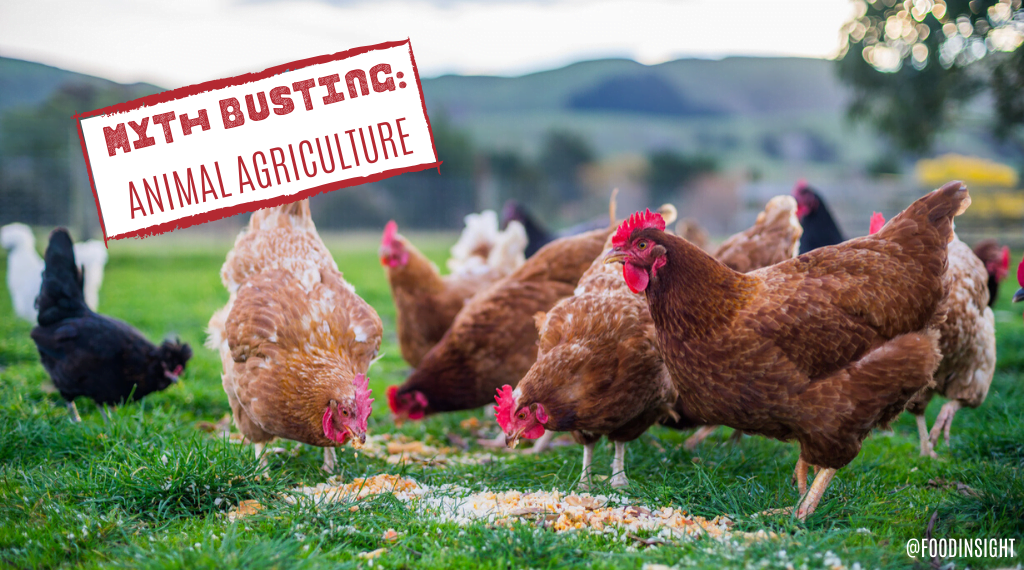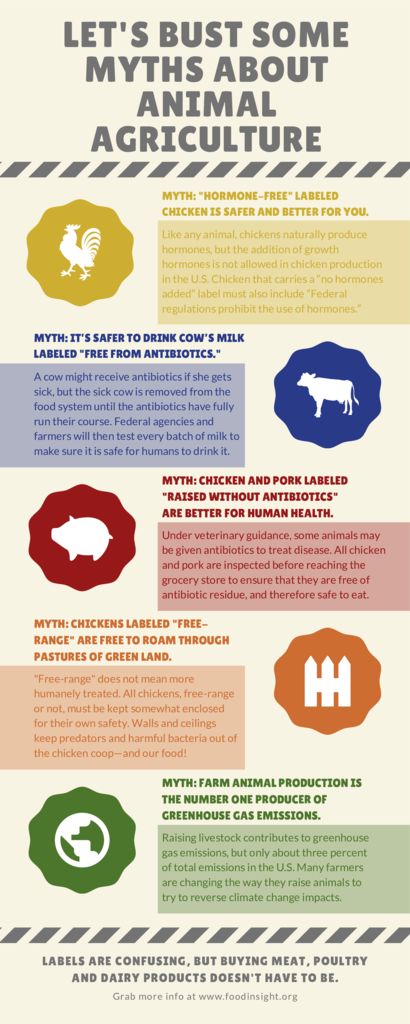Hired farmworkers make up less than 1 percent of all hired labor in the U.S., but they feed us all. This means that an even smaller percentage of hired hands are responsible for caring for all the animals that will contribute to our food supply. Although they are a small group, they are still mighty and diligent. These farmers and ranchers care for their animals in a multitude of ways. While it’s hard to know what farmers are actually doing by just reading labels on food packaging, it’s also difficult to know if those labels mean a product is healthier or safer for us. Let’s set the record straight on some common safety, health and quality misconceptions for farm-animal-derived products with some good ol’ myth-busting.
Myth: “Hormone-free” labeled chicken is safer and better for you.
Truth: There is no such thing as a hormone-free animal product. All animals, including humans, naturally produce hormones. The size of chicken thighs in today’s grocery stores may be bigger than what your grandma used to buy, but the administration of growth hormones is not allowed in chicken production in the U.S. The big reason chickens are larger now than they were in the 1950s and 60s is related to selective breeding and genetic differences. Improvements in processing have also contributed to the size and immense availability of chicken in grocery stores now, but the injection of hormones is not a part of this development. To try to prevent confusion and increase transparency, federal law states that all chicken that carries a “no hormones added” label must also carry the label “Federal regulations prohibit the use of hormones.”
Myth: It’s safer to drink cow’s milk labeled “free from antibiotics.”
Truth: All pasteurized cow’s milk on the market is safe to drink (we advise that you skip any raw milk). While some dairy cows receive antibiotics (with veterinary guidance) to treat infections and diseases, both the farmers and the Food and Drug Administration (FDA) inspect batches of milk to ensure their safety for human consumption. Also, an animal treated with antibiotics is removed from the food system until the antibiotics have fully metabolized through that animal’s system. The milk is then tested to ensure it is safe for the humans who drink it.
The FDA is also responsible for approving the use of drugs and hormones for cattle, including rBST (recombinant bovine somatotropin). This is a growth hormone that may be used to increase milk production. However, rBST has been linked with increased incidence of mastitis, or udder infections, and subsequent increased use of antibiotics for treatment. Many dairy farms at this time do not use rBST, but those that do still produce safe milk.
Myth: Chicken and pork labeled “raised without antibiotics” are better for human health.
Fact: According to the U.S. Department of Agriculture (USDA), chicken and pigs may be administered antibiotics for treatment of disease. This is done with veterinary guidance. Though approximately half of chicken and pigs reportedly received antibiotics in 2015, the FDA now reports that this number has declined by 43 percent since 2015.
However, similar to the process used for dairy, the USDA Food Safety and Inspection Service (FSIS) currently uses FDA guidance to inspect meat and poultry to ensure they are free of antibiotic residue and are safe for consumption. This means that the drug must be metabolized by the animal before it can re-enter the food supply chain. Whether an animal was raised antibiotic-free or given antibiotics during its life, it’s still safe to produce foods that eventually reach the grocery store.
Myth: Chickens labeled “free-range” are free to roam through pastures of green land.
Fact: According to the USDA, in order to use the “free-range” label, producers must demonstrate that the poultry has been allowed access to the outside. This does not necessarily mean that chickens were out on a pasture nor that they were safer than their non-free-range counterparts. While some chickens may only have a door outside the coop to a small fenced-in area, this does not mean the chickens are less content or that they are not humanely treated. In fact, for safety reasons, all chickens, free-range or not, must be kept somewhat enclosed for their own safety. The FDA recommends guidelines for walls and ceilings to prevent both predators and wildlife droppings (which may carry harmful bacteria) from entering the chicken coop. They also suggest a strict swab collection protocol to test both chickens and eggs for certain bacteria to prevent foodborne illness.
Myth: Farm animal production is the number one producer of greenhouse gas emissions.
Fact: Livestock, especially cattle, do contribute to greenhouse gas emissions, but this contribution is only about three percent of total emissions in the U.S. Transportation is actually the greatest contributor, comprising 29 percent of total U.S. emissions. According to the U.S. Environmental Protection Agency (EPA), greenhouse gas emissions from agriculture have increased in the past 30 years related to the combined methane and nitrous oxide emissions that come from livestock management, so it’s not a secret that farm animals can contribute to climate change. Many ranchers and farmers, however, are changing the way they raise animals to reduce emissions and try to reverse climate change impacts.
Buying meat, poultry and dairy products doesn’t have to be scary or confusing when you have a bit of label-reading savvy. Now that we’ve busted these myths about animal production, you should feel well prepared to peruse the grocery store’s meat section or order your favorite burger at a restaurant. Rest assured that both farmers and federal agencies take measures throughout the supply chain to help ensure that the food that reaches our plates is safe and high-quality.
This blog post was written by Courtney Schupp, MPH, RD.

